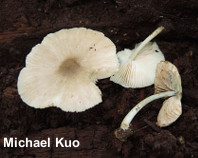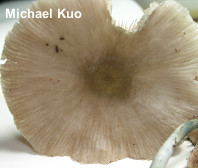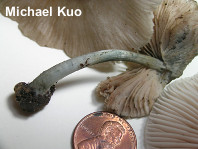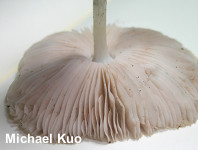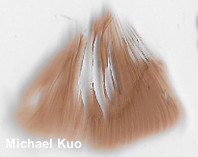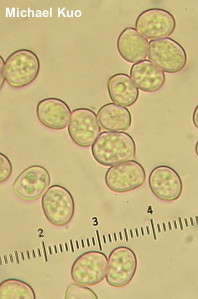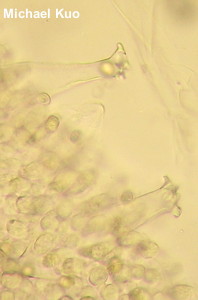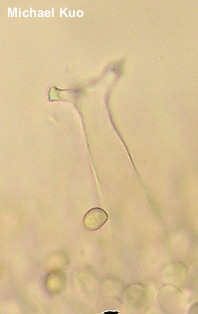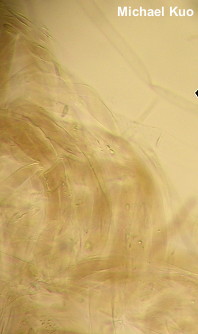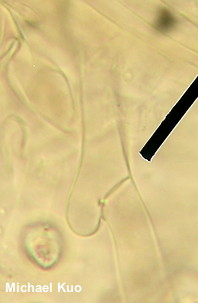| Major Groups > Gilled Mushrooms > Pink-Spored > Pluteus > Pluteus americanus |

|
Pluteus americanus [ Basidiomycota > Agaricales > Pluteaceae > Pluteus . . . ] by Michael Kuo Pluteus americanus is one of only a few species of Pluteus that stains blue, on the stem and the gills, when fresh. In North America the species has traditionally gone under the name Pluteus salicinus--but the latter species, recent research indicates, is strictly European (see Justo and collaborators, 2014). Pluteus americanus appears on the deadwood of hardwoods east of the Rocky Mountains—and, oddly enough, in eastern Russia. Crucial microscopic features for Pluteus americanus, which should be checked if your goal is to eliminate all known look-alikes, include the pileipellis (a cutis), the pleurocystidia (with well-developed apical prongs), and the cheilocystidia (which are clavate). Matching these details will eliminate Pluteus cyanopus and Plutues phaeocyanopus (both with a cellular pilepellis), and the poorly-known Pluteus saupei (pleurocystidia with poorly developed prongs, cheilocystidia lageniform). Description: Ecology: Saprobic; growing gregariously on decaying logs of hardwoods; summer and fall; probably widely distributed east of the Rocky Mountains in North America; also recorded from eastern Russia. The illustrated and described collection is from Illinois. Cap: 4–7 cm; broadly convex at first, expanding to planoconvex or flat; moist when fresh; very finely scaly over the center, but bald elsewhere; dark grayish brown when young and fresh, fading markedly as it dries out and eventually becoming very pale grayish brown or gray, with a darker center; the margin becoming finely lined for 10–15 mm. Gills: Free from the stem or nearly so; close; short-gills frequent; white at first, becoming pink and, eventually, brownish pink; bruising grayish blue. Stem: 4–6 cm long; 3–5 mm thick; equal above a slightly swollen base; bald or finely hairy; dry; whitish, becoming brownish with age; bruising slowly grayish blue; basal mycelium white. Flesh: Very thin; white; unchanging when sliced. Odor and Taste: Not distinctive. Chemical Reactions: KOH negative on cap surface. Spore Print: Brownish pink. Microscopic Features: Spores 7–8 x 5–6 µm; broadly ellipsoid; smooth; hyaline with granular contents in KOH; inamyloid. Pleurocystidia 60–100 x 12–15 µm; subcylindric to widely lageniform, with apices crowned by 4–6 well-developed projections; walls 1–2 µm thick; hyaline in KOH. Cheilocystidia clavate; thin-walled; hyaline in KOH; abundant. Pileipellis a cutis; elements 4–10 µm wide, hyaline to faintly brown in KOH, smooth, septate, clamped at septa; terminal cells cylindric with rounded to subacute apices. REFERENCES: (P. Banerjee & Sundberg, 1993) Justo, E. F. Malysheva & Minnis, 2014. (Kauffman, 1918; Singer, 1956; Banerjee & Sundberg, 1995; McNeil, 2006.) Herb. Kuo 07211502. This site contains no information about the edibility or toxicity of mushrooms. |
© MushroomExpert.Com |
|
Cite this page as: Kuo, M. (2016, June). Pluteus americanus. Retrieved from the MushroomExpert.Com Web site: http://www.mushroomexpert.com/pluteus_americanus.html |
